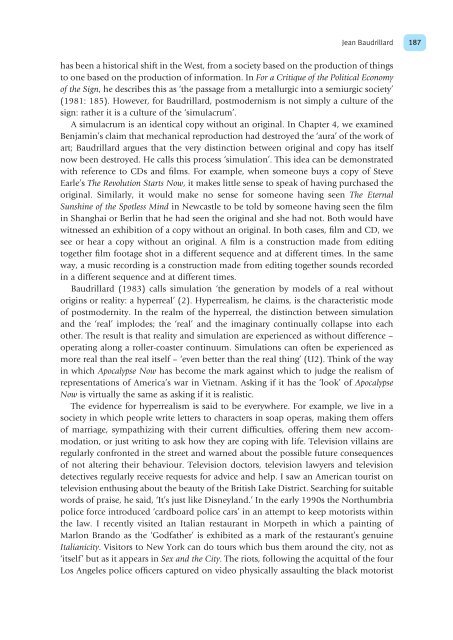Cultural Theory and Popular Culture
Cultural Theory and Popular Culture
Cultural Theory and Popular Culture
You also want an ePaper? Increase the reach of your titles
YUMPU automatically turns print PDFs into web optimized ePapers that Google loves.
Jean Baudrillard 187<br />
has been a historical shift in the West, from a society based on the production of things<br />
to one based on the production of information. In For a Critique of the Political Economy<br />
of the Sign, he describes this as ‘the passage from a metallurgic into a semiurgic society’<br />
(1981: 185). However, for Baudrillard, postmodernism is not simply a culture of the<br />
sign: rather it is a culture of the ‘simulacrum’.<br />
A simulacrum is an identical copy without an original. In Chapter 4, we examined<br />
Benjamin’s claim that mechanical reproduction had destroyed the ‘aura’ of the work of<br />
art; Baudrillard argues that the very distinction between original <strong>and</strong> copy has itself<br />
now been destroyed. He calls this process ‘simulation’. This idea can be demonstrated<br />
with reference to CDs <strong>and</strong> films. For example, when someone buys a copy of Steve<br />
Earle’s The Revolution Starts Now, it makes little sense to speak of having purchased the<br />
original. Similarly, it would make no sense for someone having seen The Eternal<br />
Sunshine of the Spotless Mind in Newcastle to be told by someone having seen the film<br />
in Shanghai or Berlin that he had seen the original <strong>and</strong> she had not. Both would have<br />
witnessed an exhibition of a copy without an original. In both cases, film <strong>and</strong> CD, we<br />
see or hear a copy without an original. A film is a construction made from editing<br />
together film footage shot in a different sequence <strong>and</strong> at different times. In the same<br />
way, a music recording is a construction made from editing together sounds recorded<br />
in a different sequence <strong>and</strong> at different times.<br />
Baudrillard (1983) calls simulation ‘the generation by models of a real without<br />
origins or reality: a hyperreal’ (2). Hyperrealism, he claims, is the characteristic mode<br />
of postmodernity. In the realm of the hyperreal, the distinction between simulation<br />
<strong>and</strong> the ‘real’ implodes; the ‘real’ <strong>and</strong> the imaginary continually collapse into each<br />
other. The result is that reality <strong>and</strong> simulation are experienced as without difference –<br />
operating along a roller-coaster continuum. Simulations can often be experienced as<br />
more real than the real itself – ‘even better than the real thing’ (U2). Think of the way<br />
in which Apocalypse Now has become the mark against which to judge the realism of<br />
representations of America’s war in Vietnam. Asking if it has the ‘look’ of Apocalypse<br />
Now is virtually the same as asking if it is realistic.<br />
The evidence for hyperrealism is said to be everywhere. For example, we live in a<br />
society in which people write letters to characters in soap operas, making them offers<br />
of marriage, sympathizing with their current difficulties, offering them new accommodation,<br />
or just writing to ask how they are coping with life. Television villains are<br />
regularly confronted in the street <strong>and</strong> warned about the possible future consequences<br />
of not altering their behaviour. Television doctors, television lawyers <strong>and</strong> television<br />
detectives regularly receive requests for advice <strong>and</strong> help. I saw an American tourist on<br />
television enthusing about the beauty of the British Lake District. Searching for suitable<br />
words of praise, he said, ‘It’s just like Disneyl<strong>and</strong>.’ In the early 1990s the Northumbria<br />
police force introduced ‘cardboard police cars’ in an attempt to keep motorists within<br />
the law. I recently visited an Italian restaurant in Morpeth in which a painting of<br />
Marlon Br<strong>and</strong>o as the ‘Godfather’ is exhibited as a mark of the restaurant’s genuine<br />
Italianicity. Visitors to New York can do tours which bus them around the city, not as<br />
‘itself’ but as it appears in Sex <strong>and</strong> the City. The riots, following the acquittal of the four<br />
Los Angeles police officers captured on video physically assaulting the black motorist
















